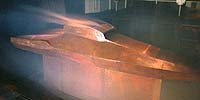
 The Hyper-X program is a five-year, $185 million effort to demonstrate future hypersonic propulsion and airframe technologies. While vehicles with conventional rocket engines carry oxygen on board, the air-breathing X-43A scramjet ingests and compresses oxygen from the atmosphere using the vehicle's uniquely shaped airframe. |
 Huntsville - May 15, 2001
Huntsville - May 15, 2001 St. Louis - Feb. 7, 2001
St. Louis - Feb. 7, 2001 Edwards - Feb. 2, 2001
Edwards - Feb. 2, 2001 Sydney - Jan. 6, 2000
Sydney - Jan. 6, 2000 Ann Arbor - Jan. 6, 2000
Ann Arbor - Jan. 6, 2000 Sydney - Jan. 6, 2000
Sydney - Jan. 6, 2000 Sacramento - Nov. 27, 2000
Sacramento - Nov. 27, 2000 London - Oct. 28, 2000
London - Oct. 28, 2000
SPACE.WIRE |